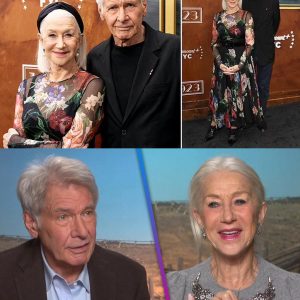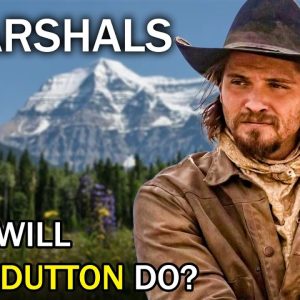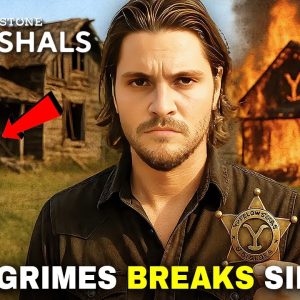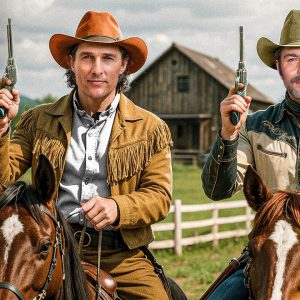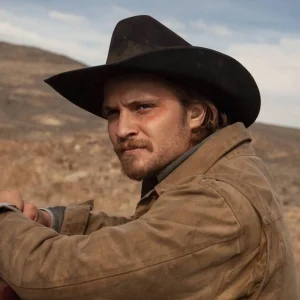You might think you understand Taylor Sheridan — the cowboy hats, the dusty ranches, the snarling family drama of Yellowstone — but what you’ve seen on screen only scratches the surface. Behind every intense stare, thunderous gallop, and shocking betrayal in the Yellowstone universe stands a man who isn’t just writing the story — he’s living it. Taylor Sheridan is not a Hollywood writer trying to capture the West. He is the West. And the empire he’s building is as real, raw, and relentless as the characters he creates.
Let’s crack open the Sheridan Code — a blend of grit, genius, and gall — and see how one cowboy turned himself into the most powerful storyteller on television today.
From Saddle to Script: Sheridan’s Cowboy Roots
Long before Yellowstone became appointment TV, Sheridan was already immersed in the kind of world most Hollywood creators could only research. Raised in Cranfills Gap, Texas, Sheridan didn’t just admire cowboy life — he lived it. Breaking horses, hauling hay, working ranches — he earned his calluses before he ever earned a writing credit. That authenticity seeps through every script he writes. Sheridan’s stories don’t smell like movie sets. They smell like sweat, leather, and the dust of real life on the plains.
And that’s by design. Where most screenwriters might take a weekend retreat to a dude ranch for inspiration, Sheridan went all in — training in competitive reining, investing in elite livestock, and ultimately purchasing the legendary Four Sixes Ranch. At over 260,000 acres, this isn’t just real estate. It’s a working ranch, a set, and the soul of his cowboy universe all in one. And soon, it will be the focal point of the next spin-off series in the Yellowstone saga. Sheridan didn’t just buy a ranch — he bought history, and now he’s turning it into story.
Owning the Land and the Legacy
The purchase of the Four Sixes wasn’t just a flex. It was Sheridan declaring that if he was going to write about the West, he was going to own it — literally. Most Hollywood moguls, when flush with studio money, spring for Malibu beach houses or Aspen ski chalets. Sheridan saddled up and bought the ground his stories ride across.
What’s more remarkable? He runs the ranch — not as a novelty but as a genuine cowboy operation. Horses bred on his property have gone on to win national titles. His cattle operation is no prop. And yes, many of the horses you see galloping across Yellowstone and 1883? Sheridan’s own.
That razor-sharp authenticity allows Sheridan to blur the line between fiction and reality until there’s almost no line at all. A character struggling with a wild colt or a ranch hand battling drought? Those moments come from real life, not some screenwriter’s Wikipedia rabbit hole.
From Side Actor to Hollywood Kingmaker
It’s easy to forget that Sheridan started on the other side of the camera. A working actor in shows like Sons of Anarchy and Veronica Mars, he often found himself typecast as the brooding tough guy — a presence, not a voice. But Sheridan wanted more. Frustrated by a lack of agency and uninspired scripts, he made the leap from acting to writing.
And Hollywood wasn’t ready.
His breakout as a writer came with Sicario and Hell or High Water, which stunned critics and audiences with their moral complexity, sharp dialogue, and brutal beauty. Suddenly, Sheridan wasn’t just another actor trying to write — he was the future of genre storytelling.
When Yellowstone debuted, it didn’t take long to realize it wasn’t just a series. It was the foundation of a new mythology. And Sheridan didn’t wait for greenlights or studio nods. He seized control. Writing, directing, and producing — he became the architect of an entire world that would eventually span centuries with 1883, 1923, Lawmen: Bass Reeves, and the upcoming Four Sixes spinoff.
The Sheridan Method: No Writers Room, No Compromises
If Sheridan has a secret weapon, it’s this — he writes everything himself. Entire seasons. Multiple series. Solo. No room of hired scribes, no brainstorm retreats, no script doctoring. Just one man and a keyboard.
Some call it audacious. Others call it insane. But the results are undeniable. Sheridan’s shows have a distinctive voice — sharp, poetic, mythic. Every silence lingers. Every line cuts. That’s because there’s no dilution. The DNA of every scene is pure Sheridan.
It’s also a matter of control. Sheridan has built an empire by demanding — and receiving — near-total creative autonomy. When he signed his massive $200 million-plus deal with Paramount, it came with a level of power few creatives ever achieve. He doesn’t pitch ideas. He delivers finished visions. And the studio, knowing his track record, nods.
In a world where most showrunners answer to multiple layers of executives, Sheridan answers only to himself. He’s not a writer who plays by Hollywood’s rules. He’s the one rewriting them — in dirt, not ink.
The Silent Gunslinger of TV Power
Despite his success, Sheridan has remained famously reclusive. No glitzy interviews. No red carpet parades. You won’t find him chasing headlines or TikTok fame. That low profile has only amplified his mystique. Fans may know the world he’s built, but they know little about the man behind it.
But his silence isn’t detachment. It’s discipline. Sheridan speaks through his work — and the numbers speak loudly. Yellowstone consistently ranks as one of the most-watched shows on cable. His spin-offs dominate streaming charts. And while others scramble to figure out the next big franchise, Sheridan is already five moves ahead, writing it himself.
His attitude? If it’s fake, burn it down. If it’s real, put it on screen. No fluff. No filler. Just stories that matter — about land, blood, betrayal, and legacy.
What’s Next: Empire Expansion
Sheridan’s empire isn’t shrinking. It’s expanding — fast. With Yellowstone nearing its conclusion and 1923 poised for a gripping second season, his frontier keeps growing. There are whispers of more spin-offs, more characters, more timelines. And always, more ranches.

What makes it all work isn’t just that the shows are popular — it’s that they feel necessary. In an age of recycled IP and CGI overload, Sheridan gives audiences something grounded. Something dangerous. Something real.
He’s not just delivering television. He’s offering a mythology for the modern American West — a place where land still matters, where families fight for legacy, and where justice comes not from courtrooms, but from horseback.
Final Thought
Taylor Sheridan didn’t wait for a seat at the table. He built the damn table, nailed it to the ground, and dared anyone to try to move it. He’s part cowboy, part Shakespeare, part mogul. But above all, he’s a storyteller who refuses to compromise.
And in today’s Hollywood — that makes him the most dangerous man with a pen.
So, next time you watch Yellowstone, remember: you’re not just watching a show. You’re watching the tip of the spear — a man’s real life, values, and legacy carved into every frame.
Drop your favorite Sheridan scene in the comments. And remember — legacy isn’t given. It’s written.
